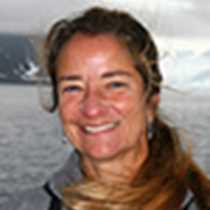The waters at this location are very productive. Converging water masses mix together, bringing nutrient-rich waters to the surface. Photosynthesis of single-celled algae starts the food chain, and tiny, drifting animals feast on the algae. They, in turn, are consumed by larger animal plankton. The whales feast on the bounty of food at this low level of the food web. Counted in numbers instead of size, these tiny "drifters", or lankton, are far more numerous than the whales many people have come here to see.
The chief mate slowed the ship a few hundred yards away from the whales, and we deployed the plankton net. Within a couple of minutes, we collected hundreds of tiny animals. Using our video microscope, we identified crustaceans called copepods, fish eggs, and snail, clam and worm larvae. Millions of tiny larval snails were frantically beating their tiny larval "wings" when we had collected plankton earlier in the day.
The whales, sea lions, sea otters, and salmon would not survive without plankton. A small net and a microscope bring this wondrous, watery, miniature world into focus.
Here is a microscopic jellyfish. . .but what do you see?




